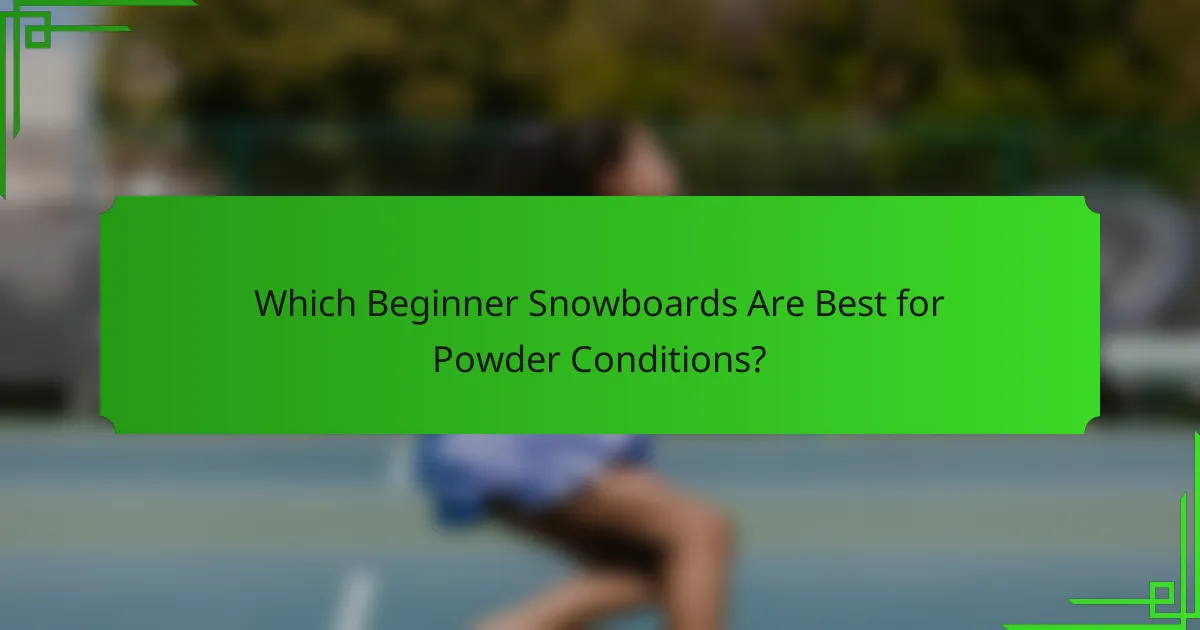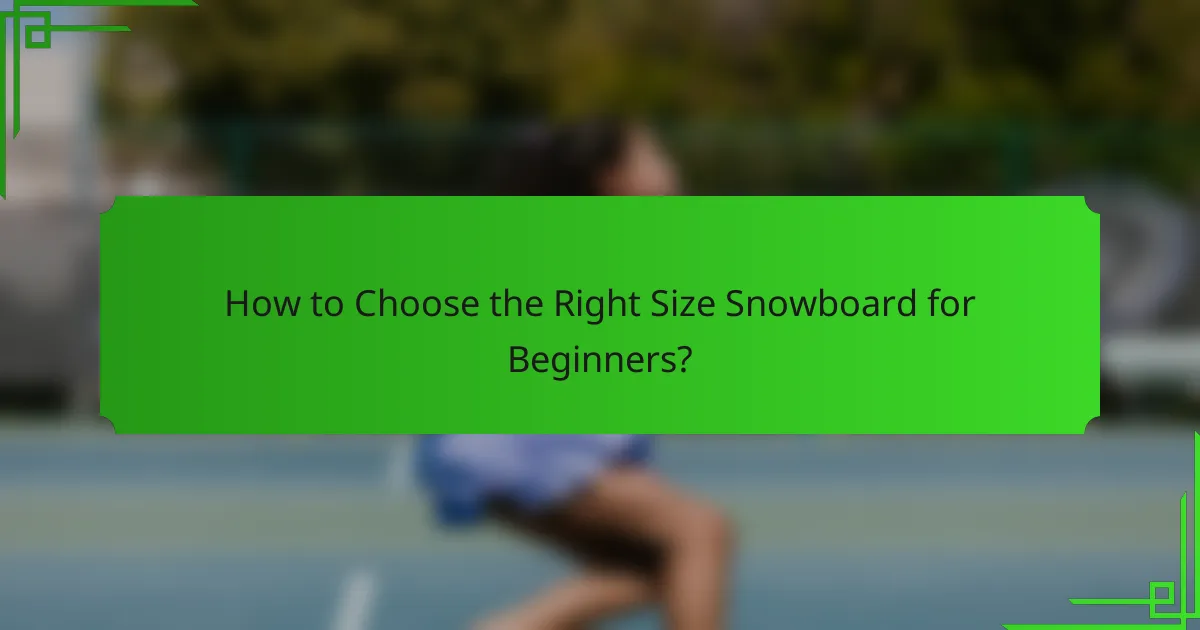Choosing the right snowboard is crucial for beginners, as different snow conditions require specific features for an enjoyable experience. For powder, wider noses and tapered tails enhance floatation, while groomed runs benefit from boards that prioritize stability and control. Additionally, some models are tailored to handle icy conditions, offering improved grip and stability for new riders navigating challenging surfaces.

Which Beginner Snowboards Are Best for Powder Conditions?
For beginners looking to ride in powder conditions, snowboards that offer a wider nose and a tapered tail are ideal. These features help with floatation and maneuverability in deep snow, making the experience more enjoyable and less challenging.
Burton Custom Smalls
The Burton Custom Smalls is designed specifically for young riders and excels in powder due to its directional shape and rocker profile. This snowboard allows for easy turn initiation and provides stability, making it a great choice for beginners venturing into deeper snow.
With a lightweight construction, it’s easy to handle, and the soft flex helps young riders maintain control without feeling overwhelmed. This board is suitable for riders weighing up to around 100 pounds.
Lib Tech Gnu Kids’ Snowboard
The Lib Tech Gnu Kids’ Snowboard features a unique hybrid camber profile that enhances float in powder while still providing edge control on groomed runs. This versatility makes it a solid option for beginners who want to explore various snow conditions.
Its environmentally friendly construction and durable materials ensure that it can withstand the rigors of learning, while the playful flex allows for easy maneuvering in soft snow. It’s recommended for kids weighing between 50 to 120 pounds.
Salomon Pulse
The Salomon Pulse is a reliable choice for beginners in powder, featuring a wide nose and a tapered tail that help with floatation. Its soft flex makes it forgiving, allowing new riders to gain confidence while learning to navigate through deeper snow.
This board is equipped with a flat profile that provides stability and ease of use, making it suitable for various skill levels. It’s best for riders weighing up to about 150 pounds, ensuring a comfortable fit for most beginners.
Roxy Mini Shred
The Roxy Mini Shred is tailored for young female riders, offering a lightweight design that excels in powder conditions. Its rocker profile enhances floatation, making it easier for beginners to stay on top of the snow.
This board is designed for girls weighing around 50 to 100 pounds and features a soft flex that promotes easy turning and control. It’s a great option for those looking to build skills in powder while having fun.
K2 Vandal
The K2 Vandal is a versatile snowboard that performs well in powder, thanks to its directional shape and rocker profile. This board is designed to help beginners learn the basics while also allowing for progression in deeper snow.
With a forgiving flex and a lightweight construction, the Vandal is easy to handle, making it suitable for riders weighing up to 140 pounds. Its design encourages confidence, allowing new riders to explore powder without fear.

What Are the Top Beginner Snowboards for Groomed Runs?
For beginners looking to tackle groomed runs, the best snowboards are designed for stability, ease of control, and forgiving flex. These boards help new riders build confidence while mastering their skills on smooth, well-maintained slopes.
Burton Chopper
The Burton Chopper is an excellent choice for beginners due to its soft flex and lightweight design. This snowboard features a flat profile that enhances stability, making it easier to balance and turn on groomed runs.
Its Catch-Free Edge technology minimizes the chances of catching an edge, allowing new riders to focus on their technique without worrying about falls. The Chopper is available in various sizes, accommodating different heights and weights.
Ride Wildheart
The Ride Wildheart is another solid option for novice snowboarders, offering a blend of playfulness and stability. Its directional shape and rocker profile provide a smooth ride, especially on groomed trails.
This board is designed to help beginners progress quickly, as it allows for easy turns and a forgiving ride. The Wildheart’s construction also ensures durability, making it a reliable choice for those just starting out.
GNU B-Nice
The GNU B-Nice is tailored for beginner to intermediate riders, featuring a soft flex and a hybrid rocker-camber profile. This design offers the best of both worlds, providing stability on groomed runs while allowing for easy maneuverability.
With its Magne-Traction edges, the B-Nice enhances grip on hard-packed snow, ensuring confidence in turns. This board is versatile enough for various conditions, making it a great investment for new riders.
K2 Lil Kat
The K2 Lil Kat is specifically designed for young riders, making it an ideal choice for beginners. Its lightweight construction and soft flex help smaller snowboarders learn the basics without feeling overwhelmed.
This board features a catch-free rocker profile, which promotes easy turning and reduces the risk of falls. The Lil Kat is perfect for kids looking to enjoy groomed runs while developing their skills in a safe and fun manner.

How Do Beginner Snowboards Perform in Icy Conditions?
Beginner snowboards generally struggle in icy conditions due to their softer flex and less aggressive edge hold. However, certain models are designed to provide better grip and stability, making them more suitable for these challenging surfaces.
Capita Micro-Scope
The Capita Micro-Scope is known for its forgiving flex, which helps beginners navigate icy slopes with more confidence. Its flat-to-rocker profile allows for easier turn initiation while maintaining decent edge control on hard-packed snow.
When riding on ice, the Micro-Scope’s lightweight construction aids in maneuverability, but riders should be cautious as it may not hold an edge as well as stiffer boards. It’s best suited for those still mastering their skills and looking for a playful ride.
Rossignol Jibsaw
The Rossignol Jibsaw offers a balanced performance in icy conditions, thanks to its hybrid profile that combines camber and rocker. This design enhances edge grip while allowing for smoother transitions, making it a solid choice for beginners tackling icy terrain.
With a medium flex, the Jibsaw provides stability and responsiveness, which can help riders feel more secure on slick surfaces. However, beginners should practice their technique to maximize the board’s potential in challenging conditions.
Atomic Punx
The Atomic Punx is designed with a focus on freestyle, but it performs surprisingly well in icy conditions due to its sturdy construction and effective edge technology. Its camber profile ensures good edge hold, which is crucial when navigating hard-packed snow.
While the Punx excels in park settings, its versatility allows beginners to explore icy slopes with confidence. Riders should be aware that its stiffer flex may require more skill to handle effectively, making it better suited for those who have progressed beyond the absolute beginner stage.

What Features Should Beginners Look for in Snowboards?
Beginners should focus on snowboards that offer a balance of stability, ease of control, and versatility across different snow conditions. Key features to consider include flexibility, length, width, and sidecut radius, as these will significantly impact the learning experience.
Flexibility
Flexibility in a snowboard affects how easily it can turn and absorb shocks. For beginners, a softer flex is generally recommended, as it provides better control and is more forgiving during turns. A flex rating in the low to mid-range is ideal for those just starting out.
As you progress, you may want to explore stiffer boards, which offer more stability at higher speeds. However, starting with a flexible board will help build confidence and technique without overwhelming you.
Length
The length of a snowboard is crucial for balance and maneuverability. A general rule of thumb is to choose a board that reaches between your chin and nose when stood upright. This typically translates to lengths of around 140-160 cm for most beginners.
Shorter boards are easier to turn and control, while longer boards provide more stability at speed. Beginners should prioritize shorter lengths to facilitate learning basic skills before transitioning to longer boards as they gain experience.
Width
Width is an important consideration to ensure that your boots fit comfortably without hanging over the edges. A board that is too narrow can lead to toe or heel drag, which can hinder performance. Most beginners should look for a standard width that accommodates their boot size, typically around 25-26 cm for sizes 8-10.
If you have larger feet, consider a wide board to maintain proper balance and control. Ensuring the right width will enhance your riding experience and help you progress more quickly.
Sidecut Radius
The sidecut radius determines how easily a snowboard can turn. A smaller radius allows for tighter turns, which is beneficial for beginners learning to navigate slopes. A sidecut radius between 6-8 meters is often recommended for those just starting.
As you improve, you may prefer a larger radius for more stability at higher speeds. However, starting with a board that has a smaller sidecut radius will help you develop essential turning skills without feeling overwhelmed.

How to Choose the Right Size Snowboard for Beginners?
Choosing the right size snowboard is crucial for beginners to ensure comfort and control on the slopes. The ideal board size depends on factors such as weight, height, and skill level, which all play a significant role in your overall snowboarding experience.
Weight Considerations
Your weight is one of the most important factors in selecting a snowboard size. Generally, heavier riders require longer boards for better stability, while lighter riders benefit from shorter boards for easier maneuverability. A good rule of thumb is to look for a board that falls between your chin and nose when standing on its tail.
Most snowboard manufacturers provide weight ranges for each board size, so check these specifications to find a suitable match. For example, if you weigh around 150-180 lbs, a board length of 155-160 cm may be ideal.
Height Guidelines
Height also influences snowboard size, but it should be considered alongside weight. Taller riders may need longer boards to maintain balance and control. As a general guideline, a board should reach between your chin and forehead when standing upright.
For instance, a rider who is 5’6″ might choose a board around 150-155 cm, while someone who is 6’0″ could opt for a board in the 160-165 cm range. Always cross-reference height with weight to ensure the best fit.
Skill Level
Your skill level significantly impacts the snowboard size you should choose. Beginners often benefit from shorter boards, which are easier to turn and control. As you progress, you may want to transition to a longer board for increased stability at higher speeds.
For novice riders, a board that is 5-10 cm shorter than the recommended size based on weight and height can enhance learning. Consider your comfort level and how quickly you plan to advance when selecting your board size.
